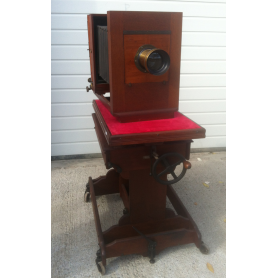No products
Prices are tax excluded
Detailed privacy of the user registry: Here
Legal notice and detailed cookies policy. By continuing to use the site, you accept our use of cookies: Find out more.
200.19
Used
Magnifies camera studio in perfect condition in wood and glass.
Numbered: 31549 principles of s. XX
Easel adjustable original.
Measures: 120x90x45cm
Warning: Last items in stock!
Availability date:

Studio camera from Voigtlander & John. Circa 1900.
Magnifies camera studio in perfect condition in wood and glass.
Numbered: 31549 principles of s. XX
Easel adjustable original.
Measures: 120x90x45cm
Recipient :
* Required fields
or Cancel
| State | Original |
The invention of the camera in the 19th century has given rise to a great variety of lens designs intended for photography . The problems of design of the camera lens , creating a lens for a task that would cover a large image plane flat, were well known even before the invention of photography , due to the development of lenses to work with the focal plane of the camera obscura , a device for projecting images used as a novelty, and the help of drawing of a artist that has been around for hundreds of years. Since the invention of photography many types of lenses have been tried. The succession of designs was never uniform since an old design that performed a task the photographer needed (such as working better portrait versus landscape, which works in the wavelength of the light of the movie collection, etc) is still used in unison with the new designs. Even today the job the lens needs to do, the laws of physics, the limits of engineering, as well as the practical considerations of size, weight and cost, means that there are many designs available.
József Miksa Petzval in Hungarian and Jozef Maximilián Petzval in Slovak and German (January 6, 1807-17 September 1891) was a mathematician and professor at the University of Vienna, whose contributions to the field of optical photographic allowed to reduce up to one-third the time required to perform the taking of a daguerreotype.
He was born in Spišská Belá the Kingdom of Hungary, although now it belongs to Slovakia. His father was a teacher in the city though his origin was German, he began his elementary studies in Kežmarok and the side part in Podolínec and ended up in Levoča. His engineering studies were conducted in the Institutum Geometricum, which is called at present University of Technology and Economics Budapest, in which he remained for a time as an associate professor to become a professor of mathematics in 1835, and the following year he moved to the chair of the university of Vienna in which he was exercising until 1884.
In 1839, made the first calculation of a photographic lens by using a double combination allowed an aperture of 3.5,2 which represented a great advance to decrease to less than half the time required to perform the taking of a portrait.
In 1841 he performed the design of the lens and a camera, and the following year commissioned its manufacturing to Peter Voigtländer, the lens had a luminosity up to 16 times greater than that which was used in daguerreotypes, and the camera produced images of a circular shape.
This advance joined to the subsequent use of the accelerator chemical for daguerreotypes of John Frederick Goddard allowed a reduction in the time required until one-fourth or more.
Around 1850 he developed a lens to do landscapes but instead of ordering its construction to Voigtländer did with the viennese company Dietzler, apparently because of disagreements with the German company that is dedicated to build similar objectives using the knowledge provided previously by Petzval, which caused it to abandon the research on optics in 1862, and was devoted to the acoustics.
In 1873 he was appointed a member of the Hungarian Academy of Sciences, retiring in 1877. Although he died in oblivion has had subsequent recognitions among which we can point out that in his hometown he created a museum with his name dedicated to the history of photography. But it has also had other awards such as the give your name (Petzval) to a moon crater on the hidden face of the moon, or a large amount of streets and statues dedicated in Austria, Slovakia and Hungary. In 1980 he gave his name to a moon because their lenses telescope allowed us to find numerous planetoids in the NINETEENTH century, and since 1929 is awarded the Medal József Petzval to those persons or entities who reach achievements in the development of scientific photography.
No customer reviews for the moment.